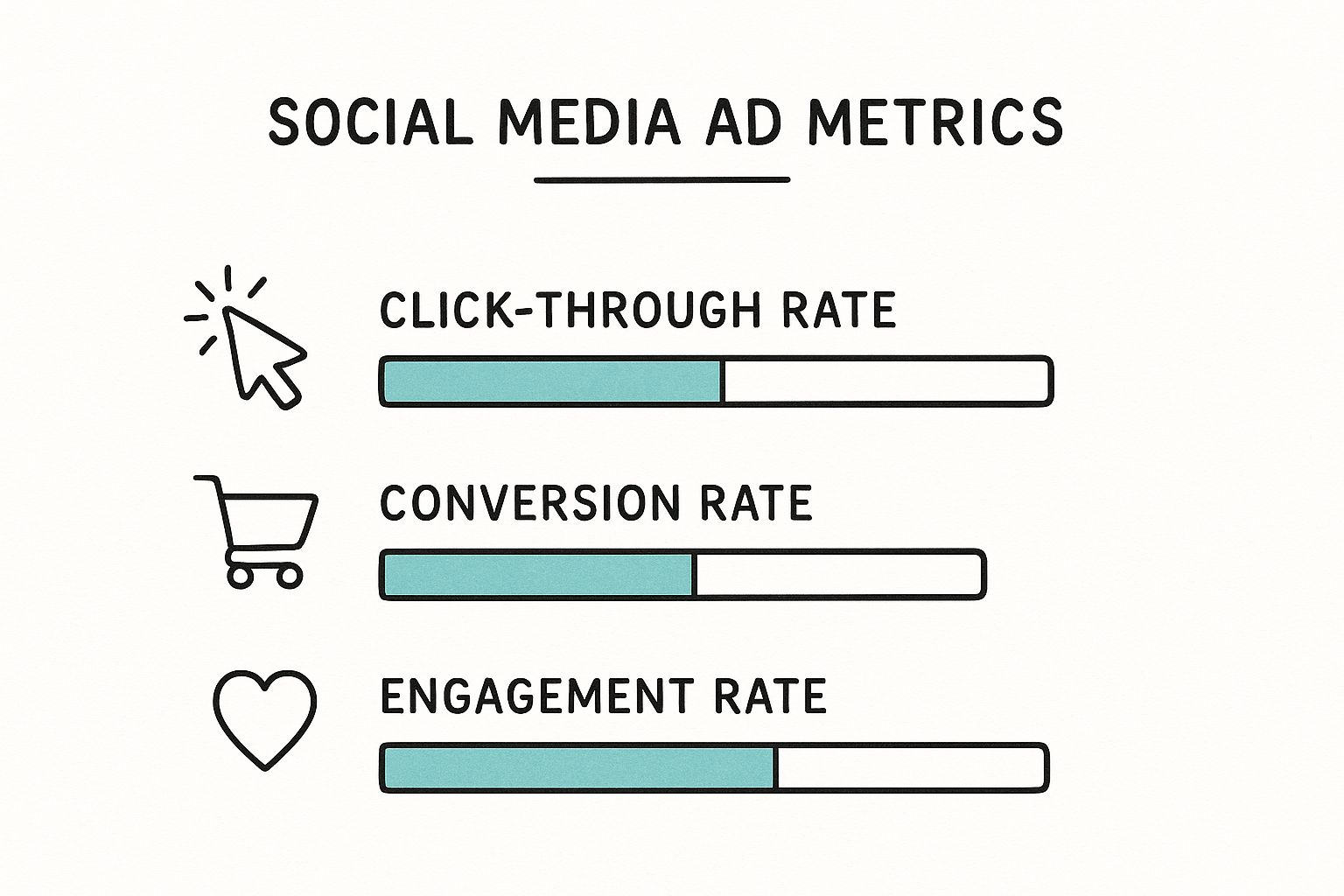Your Guide to Book Sales and Marketing

When you boil it all down, effective book marketing is really about one thing: building a bridge between your story and its ideal reader. It’s not about some secret sales trick. It's about laying a solid foundation of discoverability and connection long before you ever ask anyone to buy your book. This is how you ensure your work finds a home in an incredibly crowded marketplace.
Building Your Foundation for Lasting Sales

A truly successful book launch isn't built on luck or a single viral video. It’s the direct result of deliberate, foundational work that starts months before your publication date. This pre-launch phase is where you gain a massive advantage, transforming yourself from a hopeful author into a strategic publisher of your own work. Think of it less as shouting into the void and more as building an ecosystem where your future fans can gather.
This whole process kicks off with a deep, almost forensic understanding of your ideal reader. Going beyond basic demographics like age and gender is absolutely critical. You need to get into their heads—what drives them? What other books do they obsess over? Where do they hang out online? Answering these questions lets you find them where they already are, whether that's a niche subreddit, a specific Facebook group for gothic romance fans, or a popular BookTok hashtag.
Defining Your Book's Unique Space
Once you know who you're talking to, the next piece of the puzzle is figuring out your book's specific place in the market. This means digging into comparable titles, or "comps" as they're known in the industry. The goal isn't to copy what they're doing, but to spot patterns and uncover opportunities.
Take a look at the top 5-10 books in your specific sub-genre on Amazon or Goodreads. Pay close attention to:
- Covers: What visual styles are trending? Is there a look you can align with or, even better, cleverly subvert to stand out?
- Blurbs: What hooks are they using to grab readers? Notice the pacing, the word choice, and the promises they make.
- Keywords: What words keep popping up in their titles, subtitles, and descriptions? These are direct clues to what real readers are typing into the search bar.
Doing this research helps you position your book with intention. For example, if every sci-fi thriller in your niche features a lone-wolf protagonist but your story centers on a team, that difference becomes your unique selling proposition. It's a hook you can build your entire messaging strategy around.
Key Takeaway: Solid book marketing isn't about being the loudest voice in the room; it's about being the clearest. When you know exactly who your reader is and what makes your book different, every marketing decision you make becomes simpler and far more effective.
Assembling Your Author Platform
Your author platform is your digital home base—it’s the collection of online assets you actually own and control. This is the engine that will power all your long-term sales and marketing. A great platform doesn't need to be overly complicated, but it absolutely must be functional and feel authentic to you.
The non-negotiables are pretty straightforward:
- A Simple Website: This is your central hub. At a minimum, it needs an "about me" page, a page for your books, and a very obvious sign-up form for your email list.
- An Email List: I can't stress this enough: this is your most valuable marketing asset. Unlike social media followers, your email list is a direct line to your most dedicated readers, completely immune to algorithm changes.
- A Primary Social Media Channel: Don't try to be everywhere at once. Pick the one platform where your ideal readers gather and pour your energy into that. If your audience is highly visual, Instagram or Pinterest might be your best bet. If they love quick, personality-driven content, then BookTok could be the answer.
The global book market is a massive, growing industry, valued at around $151 billion and projected to climb to $192.1 billion by 2030. This growth isn’t just in one corner of the industry; it spans everything from blockbuster fiction to a booming digital space for ebooks and audiobooks. This proves there are countless avenues for a well-positioned book to succeed. You can learn more about these global book market trends to fully grasp the scale of the opportunity in front of you.
Making Your Book Launch an Unforgettable Event
A book launch isn't just about flipping a switch and making your book available for sale. Far from it. A truly powerful launch is a carefully orchestrated campaign, a crescendo of activity designed to create a massive wave of initial buzz and sales. Think of it less as a release date and more as a week-long party for your readers.
The whole point is to create a concentrated burst of activity that gets the attention of retail algorithms, especially on giants like Amazon. A strong launch week tells their systems, "Hey, people love this book!" That initial signal can set you up for sustained sales and visibility long after the launch confetti has settled. It’s about creating an experience that feels unmissable.
Your Secret Weapon: The Advance Reader Team
One of the most effective tools I've ever used is an Advance Reader Copy (ARC) team. This is your hand-picked group of superfans who get a free, early copy of your book. In return, they agree to leave an honest review on launch day.
Why is this so critical? Those first few reviews are pure gold. They provide immediate social proof. In fact, one study showed that products with at least five reviews have a purchase probability that’s a staggering 270% higher than those with none. A book page with zero reviews feels like an empty restaurant—no one wants to be the first one in.
But you can't just send out a generic blast on social media and hope for the best. Building a reliable team takes a personal touch.
- Start with your biggest fans. Go through your email list and social media followers. Who are the people always commenting and replying? Send them a direct, personal invitation. Make them feel like the VIPs they are.
- Lean on dedicated platforms. If you're just starting out, services like Booksprout or Voracious Readers Only can connect you with readers who are actively looking for ARCs.
- Make it easy for them. Send a simple guide with the launch date, direct links to the retail pages (Amazon, Goodreads, etc.), and a few friendly reminders. The easier you make it, the more likely they are to follow through.
My Two Cents: Don't just email the book and cross your fingers. I always create a private Facebook group or a special email list just for my ARC team. It builds a sense of community, lets you answer questions in one place, and makes the whole thing feel like a fun, collaborative project.
Mapping Out Your Launch Timeline
A great launch is all about building anticipation. You want to layer your promotional efforts over several weeks, creating multiple opportunities for people to get excited about your book. This isn't a one-and-done announcement; it's a slow burn that builds to an inferno. A solid timeline also saves your sanity and ensures every marketing beat lands with maximum impact.
Here’s a look at what a real-world promotional calendar might look like:
| Timeframe | Key Activity | Goal |
|---|---|---|
| 4-6 Weeks Before Launch | Announce the book & do a big cover reveal. | Spark that first wave of excitement and get people talking. |
| 3-4 Weeks Before Launch | Send ARCs to your review team. | Get those crucial reviews lined up and ready for launch day. |
| 2 Weeks Before Launch | Share character art, story excerpts, or behind-the-scenes content. | Pull readers deeper into your book's world and give them a taste. |
| Launch Week | Unleash the full promotional blitz. | Drive a massive, concentrated surge of sales and algorithm love. |
| 1 Week After Launch | Share glowing reviews & thank everyone. | Keep the momentum going and use that amazing social proof. |
This kind of phased approach turns your launch from a single day into an entire event.
The All-Out Launch Week Blitz
When launch week finally arrives, it’s all hands on deck. This is where all your planning pays off. Your entire focus should be on driving as much traffic and as many sales as possible, as quickly as possible.
Your email sequence should be locked and loaded, with messages ready to go out announcing the release, sharing the first amazing reviews, and creating a little friendly urgency.
Your social media should be just as coordinated. I always batch-create my launch week content ahead of time so I'm not scrambling. Your content arsenal could include:
- A sharp "It's Here!" or "Live Now!" graphic.
- Short videos of you talking about what inspired the book.
- Eye-catching graphics with powerful quotes from the story.
- Screenshots of the first 5-star reviews as they roll in (with the reviewer's permission, of course!).
By synchronizing your message across your email and social channels, you create a powerful, unified front. It sends a clear signal to readers and retailers alike that something special is happening—and that’s the very essence of a successful book launch.
Winning Readers with Social Media and Digital Trends

Let's be honest: just having a social media profile isn't a marketing strategy. It’s the bare minimum. To actually see a difference in your book sales, you have to use these platforms to build real connections and start conversations, not just shout into the void.
The real shift happens when you stop thinking about "selling a product" and start "building a community." It’s about engaging with people, sharing things they find valuable (even if it's not directly about your book), and letting them see the human behind the author name. When you build a tribe, the sales tend to take care of themselves.
The Unavoidable Power of BookTok
If you write fiction—especially romance, fantasy, or YA—you can't afford to ignore TikTok anymore. It’s that simple. The #BookTok community is a force of nature in publishing, single-handedly launching backlist titles to the top of the bestseller charts years after they were first released.
Don't worry, you don't need to be a professional dancer or video editor to make it work. Authenticity is the only thing that truly matters on the platform. Start with simple, low-pressure videos that feel like you.
- Vibe Videos: Find some free stock clips or shoot simple footage that captures the mood of your book. Slap a trending audio track on it, and you've got a compelling "aesthetic" video.
- Reading a Snippet: Just record yourself reading a powerful, non-spoilery paragraph from your book. Let your own words do the heavy lifting.
- Answering Reader Questions: The Q&A feature is gold. Use it to respond directly to comments and show potential fans you're listening.
The influence of communities like BookTok is undeniable. The global books market is projected to hit nearly $94.94 billion in revenue, and phenomena like BookTok have directly fueled a 1% bump in book sales. This just proves how digital communities can drive tangible results. You can see the full data on how digital trends are shaping the book market to grasp the scale of this shift.
My Personal Tip: Don't get overwhelmed trying to jump on every single trend. Find one or two formats that you actually enjoy making and stick with them. I once saw an author gain thousands of followers just by posting short clips of her dog sleeping on her manuscript drafts. It was simple, real, and it worked beautifully.
Beyond TikTok: Engaging Across Platforms
While TikTok grabs all the headlines, a smart author plays the whole field. Your goal is to take your core message and tailor it to the unique vibe of each platform. A solid social media plan for authors is your key to reaching the widest possible audience.
Instagram for Visuals and Quick Hits Instagram Reels are perfect for those TikTok-style short videos—think cover reveals, quick writing tips, or behind-the-scenes moments. Then you have Stories, which are fantastic for daily engagement. Use the interactive polls and question stickers to make your followers feel like they're part of your journey.
Facebook for Building Your Inner Circle Never underestimate a good old-fashioned Facebook Group. It's still one of the best ways to nurture a dedicated fan community where readers can geek out over your books, share theories, and connect with each other. Running a live Q&A on your page or in your group is another great way to spark interaction.
Pinterest for Visual World-Building Is your book set in a rich, detailed world? Pinterest can be an untapped goldmine. Create boards for your character's style, the story's key locations, or even the food mentioned in the book. It’s an immersive experience that helps readers connect with your world on a much deeper level.
To get the most bang for your buck, try to post when your audience is most active. A little research into the optimal social media posting times can make a huge difference in your reach.
Turning Followers into Superfans
Ultimately, your goal isn't just to collect followers; it's to create true fans who will champion your work. This happens when you consistently show up, provide value, and make them feel seen.
A great way to do this is by encouraging user-generated content (UGC). Run a small contest asking readers to share photos of your book "in the wild." When you share their posts (always with credit!), it provides social proof that’s far more persuasive than any paid ad.
Remember, every comment you reply to and every question you answer strengthens the bond between you and your reader. That connection is the most powerful tool in your book sales and marketing arsenal. For a deeper look at this, check out our complete guide to social media for authors.
Marketing Strategies for Every Book Format
A one-size-fits-all marketing plan is a recipe for wasted time and money. The person who loves the heft and smell of a hardcover has very different reading habits than someone who burns through audiobooks on their commute. To get real traction, you need to think about how you’ll approach each format—print, ebook, and audiobook—as its own unique challenge.
This doesn't mean you need three entirely separate, resource-draining campaigns. Instead, it’s about being smart and strategic. You’ll want to focus your efforts on the tactics that actually resonate with each type of reader, understanding where they hang out and what they value. This is how you build a cohesive plan that truly works.
Winning Over the Print Book Enthusiast
Don’t let anyone tell you print is dead. In 2022 alone, an astounding 788.7 million print books were sold in the U.S. This audience often craves the tangible experience of reading, which makes in-person events and community-focused marketing incredibly powerful. For a deeper dive into these numbers, you can explore some fascinating book sales statistics.
To really connect with these readers, you have to think locally and build genuine relationships.
- Partner with Indie Bookstores: Go beyond just asking them to stock your book. Offer to host a signing, a reading, or a Q&A session. Become a real supporter of their store by engaging with their social media and promoting them to your own followers.
- Launch a Library Campaign: Libraries are discovery goldmines. While digital services like OverDrive are great for getting your ebook into circulation, don't overlook the power of a physical copy on the shelf. Reach out to your local librarians and offer to donate a copy to their collection.
- Design a "Shelfie-Worthy" Cover: Your cover is your number one salesperson. Print readers are browsers, and a stunning, professional cover can make someone pick your book up out of a sea of others. Think about special editions, too—sprayed edges or unique interior designs can turn your book into a must-have collector's item.
Dominating the Digital-First Ebook Market
Ebook readers are all about instant access. Their entire journey, from discovery to purchase, happens online. This makes your digital storefront—especially your Amazon product page—the most critical piece of real estate you have.
This is where you need to get surgical with your optimization. Your book's page has to be a well-oiled conversion machine, compelling a casual browser to click that "Buy Now" button.
A lesson from the trenches: I once saw a 30% jump in sales for a client simply by rewriting their book's description to have a stronger hook and updating the backend keywords to match what readers were actually searching for. Same book, just packaged smarter. That’s the power of good metadata.
To succeed here, you have to master the digital shelf.
- Nail Your Keyword Optimization: Use research tools to find the exact phrases readers use when looking for books in your genre. Weave these keywords naturally into your title, subtitle, and book description.
- Consider KDP Select: Enrolling in Kindle Unlimited can be a game-changer, particularly for new authors. It removes the price barrier for millions of voracious readers to give your book a try, and you get paid for every page they read.
- Run Strategic Price Promotions: A well-timed discount can work wonders. Using a service like BookBub to run a limited-time $0.99 promo can create a massive spike in sales and visibility, rocketing your book up the charts.
This infographic breaks down some of the key advertising metrics you’ll be tracking when you start running ads for your ebook.

Getting comfortable with these numbers is crucial. It helps you understand which of your ads are grabbing attention and, more importantly, which ones are actually turning into sales.
Capturing the Audiobook Listener
The audiobook market is on fire, with double-digit growth for nearly a decade straight. Listeners are often multitasking pros, fitting stories into their workouts, drives to work, or even while doing chores. This means your marketing has to meet them in those moments and sell the pure convenience of the audio format.
On platforms like Audible, visibility is everything. Since many listeners find new books through algorithm recommendations and curated lists, getting your audiobook noticed is half the battle.
Here’s how to make a splash in the audio space:
- Find the Perfect Narrator: Your narrator’s voice is your book to this audience. Use a platform like ACX to hold auditions and find someone whose performance perfectly captures your story's tone and brings your characters to life.
- Use Audio-Specific Promos: Offer free promotional codes for review copies to audiobook bloggers and podcasters. A single positive mention on a popular podcast can introduce your book to hundreds, if not thousands, of new listeners.
- Target Your Ads: Get specific with your social media ads. You can target users based on their interest in audiobooks, their favorite narrators, or even fans of competing podcasts in your genre. Always emphasize the benefit of being able to listen anywhere, anytime.
Marketing Strategy by Book Format
Tailoring your tactics to each format is key. A print reader browses a physical store, while an audiobook listener discovers new titles on their app. The table below breaks down how you might adjust your approach for each one.
| Format | Key Marketing Tactics | Primary Platforms | Success Metrics |
|---|---|---|---|
| In-person events, bookstore partnerships, library outreach, high-quality cover design, special editions. | Independent bookstores, Barnes & Noble, libraries, book fairs, author's website. | In-store sales, library orders, positive Goodreads reviews, social media "shelfies." | |
| Ebook | Keyword optimization, price promotions, email list building, Amazon & Facebook Ads, enrolling in KDP Select. | Amazon Kindle Store, Apple Books, Kobo, BookBub, author's newsletter. | Sales rank, download numbers during promos, ad conversion rates, page reads. |
| Audiobook | Narrator selection, podcast outreach, social media ads targeting listeners, promo codes for reviewers. | Audible, Apple Books, Google Play, podcast directories, social media (Instagram, TikTok). | Units sold/listened, Audible ratings & reviews, promo code redemptions. |
By building a thoughtful plan that respects the unique habits of each reader, you create a robust book sales and marketing strategy that covers all your bases. If you're looking for more inspiration, check out our other article covering proven book marketing strategies for a broader view.
Keeping Your Book Selling Long Term
 A huge launch week is definitely worth celebrating, but it’s not the finish line. The real aim of any serious book marketing plan is to transform your book from a fleeting event into a lasting, evergreen asset. This is how you build a real career as an author—one book at a time.
A huge launch week is definitely worth celebrating, but it’s not the finish line. The real aim of any serious book marketing plan is to transform your book from a fleeting event into a lasting, evergreen asset. This is how you build a real career as an author—one book at a time.
The mental shift here is everything. Instead of chasing short-term sales spikes, you're building systems that keep your backlist humming. This is what gives you the financial breathing room and creative freedom to write your next book, knowing your previous ones are still pulling their weight.
The Art of the Price Promotion
One of the best ways to breathe new life into an older title is a well-timed price promotion. Dropping your ebook price to $0.99 or even making it free for a short period isn't about devaluing your work. It's a calculated strategy to get your writing in front of a huge new audience of bargain-hunters.
Think of it as a gateway. A reader who finds you through a freebie and loves your writing is far more likely to buy the rest of your series at full price. The trick is to get your deal featured by a major newsletter service like BookBub, Freebooksy, or Fussy Librarian. A single feature from one of these can drive thousands of downloads in just one day.
My Two Cents: Never run a price drop in a vacuum. If you’ve landed a BookBub feature, stack it with some Amazon or Facebook ads. This creates a powerful surge that the sales rank algorithms love, giving your book a massive boost.
This surge doesn't just get you immediate downloads. It juices your book's visibility for weeks, leading to more full-price sales long after the promotion ends.
Finding Strength in Author Collaborations
You don't have to do this alone. One of the most powerful, and often overlooked, marketing tactics is cross-promoting with other authors in your genre. When you team up, you can tap into each other's audiences and reach thousands of readers who are already primed to enjoy your work.
Finding the right authors to partner with is just smart networking.
- Scout for similar authors. Head over to Amazon and look for books in your specific sub-genre that have a similar style and vibe.
- Check their platform. The ideal partner has an active newsletter and an engaged following. That's your gold mine.
- Reach out professionally. A simple, personalized email suggesting a newsletter swap or a group giveaway can work wonders. Always frame it as a win-win.
These partnerships can be simple, like featuring each other's books in a newsletter, or more involved, like multi-author box sets and giveaways. If you're just starting to build these connections, our guide on how to market a book offers a fantastic roadmap.
Fueling the Fire with Paid Advertising
For consistent, long-term sales, you really can't beat paid ads. Platforms like Amazon Ads and Facebook Ads are the engines that let you predictably reach new readers every single day. The secret is to start small, test obsessively, and then pour your budget into what actually works.
Amazon Ads are brilliant because they target readers who are already in a buying mood. You can bid on specific keywords (like "enemies-to-lovers sci-fi romance") or even pop your ad right onto the sales pages of your competitors.
Facebook Ads, on the other hand, let you find readers based on their known interests. You can target people who "like" bestselling authors in your genre, follow specific book review blogs, or belong to certain reading groups. It's an incredibly effective way to grow your newsletter list, especially if you're offering a compelling free story.
Keeping Your Book Discoverable with Content
Finally, evergreen content ensures your book stays discoverable long after launch. Think of every blog post or interview as another digital breadcrumb leading readers back to your books.
Here are a few tactics that pay dividends for years:
- Guest Blogging: Writing an article for a popular blog in your genre puts your name and expertise in front of an entirely new, highly relevant audience.
- Podcast Interviews: Being a guest on a podcast is a fantastic way to connect with listeners on a more personal level. They hear your voice, they get to know you, and they're more likely to check out your work.
- Blogging on Your Own Site: Write articles that touch on your book's themes. If you wrote a historical fiction novel set in ancient Rome, posts about daily Roman life or famous battles can attract search traffic for years.
This blend of savvy promotions, smart collaborations, targeted ads, and valuable content creates a self-sustaining system. It's this very system that drives consistent backlist sales and is the heart of a successful, long-term book sales and marketing strategy.
Your Book Marketing Questions, Answered
Let's be honest, navigating the world of book marketing can feel like learning a whole new language. Even with a well-thought-out plan, certain questions and roadblocks pop up for almost every author.
I get it. I’ve seen these same concerns come up time and time again. So, let’s clear the air and tackle some of the most common challenges you'll face when trying to get your book into the hands of eager readers.
How Much Should I Actually Budget for Marketing?
This is the million-dollar question, isn't it? While there’s no one-size-fits-all answer, a solid starting point for most self-published authors is somewhere in the $500 to $2,000 range. This gets you in the game without breaking the bank.
But don't just throw that money at ads. A huge chunk of that initial budget should go toward the non-negotiables: a killer cover design and professional editing. Seriously, don't skimp here. Whatever is left over can then be put toward targeted advertising or promotional services that get you in front of your ideal readers.
If you want to get a better handle on the bigger picture, diving into some of the top marketing books to read can give you a fantastic strategic foundation.
Should I Bet on Amazon Ads or Social Media Ads?
This isn't really an either/or situation. The real question is about timing and your specific goal at that moment. Think of them as two different tools in your book sales and marketing toolbox.
- Amazon Ads are your direct sales engine. You're reaching people who are literally on Amazon with their credit card in hand, actively looking for something to read. The buying intent is incredibly high, which often translates to a faster, more direct return on your investment.
- Social Media Ads (like on Facebook or Instagram) are for building your brand and audience. You're finding potential readers based on what they love—other authors, similar genres, related hobbies. This is how you build a community, grow your email list, and create fans for life.
The smartest approach? Use both, but for different reasons. Amazon Ads can drive your immediate sales, while social media ads build the audience that will be eagerly waiting for your next book to drop.
Expert Tip: Don't pit them against each other. Use Amazon Ads for the immediate sale and social media ads for the long-term relationship. One fuels your launch week, and the other fuels your career.
How Early Is Too Early to Start Marketing?
The short answer: probably not as early as you think. You should start laying the marketing groundwork a good 3 to 6 months before your launch date.
Now, this doesn't mean you need to be screaming "PRE-ORDER MY BOOK!" for six months straight. That's a surefire way to burn out your audience.
Instead, this early period is for quiet, strategic work. It’s when you build your author website, start nurturing an email list, and—most importantly—gather an ARC (Advance Reader Copy) team. Getting those early reviews lined up is one of the most powerful things you can do to ensure your book has momentum from day one. This foundational work is what creates the launch day buzz that the algorithms (and readers) absolutely love.
Ready to turn your manuscript into a powerful marketing asset? ManuscriptReport.com builds a comprehensive marketing report for your book in minutes, complete with blurbs, keywords, ad copy, and social media posts. Spend less time on promotion and more time on what matters—your next story. Get your complete marketing kit at ManuscriptReport.com.
Related Articles

6 Essential Book Marketing Strategies for Romance Novels
Discover 6 proven strategies to market your romance novel effectively and boost sales.

7 Budget-Friendly Book Marketing Strategies: Complete Guide for Indie Authors
Master budget book marketing with 7 proven strategies that work on $0-$500 budgets. Real ROI data, free tools, and actionable tactics for indie authors.

7 Essential Book Giveaway Strategies to Build Loyalty
Discover 7 essential book giveaway strategies to boost reader loyalty and engagement.